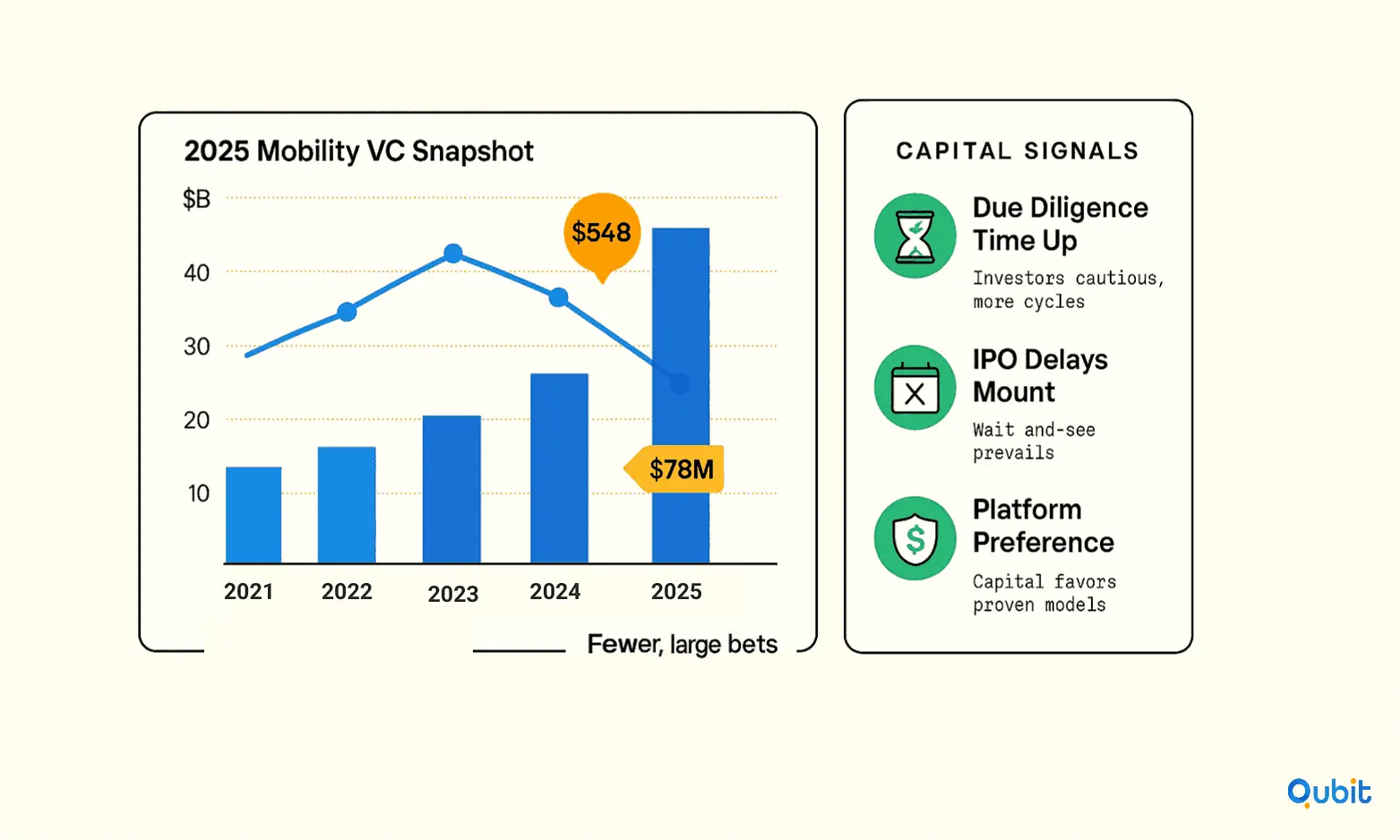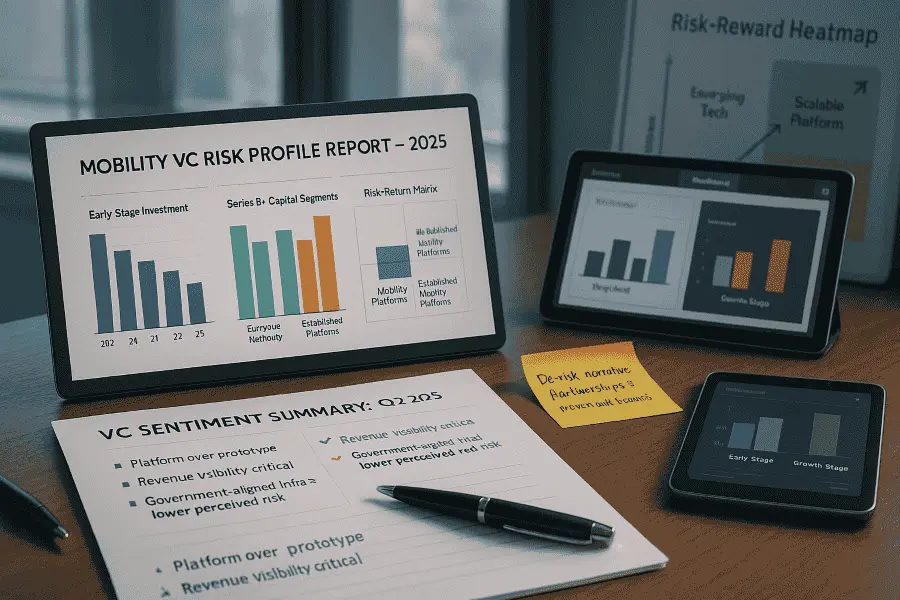For over a decade, the mobility industry, spanning electric vehicles (EVs), ride-sharing, micromobility, and autonomous solutions, has stood at the intersection of technology, infrastructure, and urban transformation. Venture capital (VC) has been the lifeblood behind this evolution, funding both daring upstarts and scaling visionaries. Yet, in 2025, the winds have shifted: macroeconomic headwinds, exit bottlenecks, and heightened scrutiny are fundamentally changing how, and where, VCs deploy their capital. The result? A discernible move away from risk-taking on early-stage mobility disruptors and toward bigger, proven platforms and advanced, asset-heavy companies.
This article dives deep into the trends and drivers behind this risk recalibration, the implications for founders and investors, and why the mobility investment landscape is entering a new era of scale and selectivity.
Let’s unpack this transformation and what it means for your next mobility venture.
The 2025 VC Climate: More Capital, Higher Bar

Macro Shocks and a Cautious Mindset
Major geopolitical and economic events have punctuated 2025, trade tariffs, inflation, and ongoing global volatility. As a result:
- Deal volumes are down and VCs are managing longer due diligence cycles.
- Funds are under pressure to prove exits, so only the most robust deals are moving forward.
- High-profile IPO delays have reinforced a “wait and see” mindset, especially for mobility tech which is notoriously capital intensive and slow to reach break-even.
The Data: Where the Money Is Going
Global venture funding for mobility spiked to $54B in 2024, the second-highest figure ever, but the number of deals declined 30% year-on-year, and the average round size hit a record $78M, reflecting a shift toward established platforms. Newer, unproven startups found it harder to secure rounds, while companies with commercial traction and mature technologies attracted outsized checks and investor demand.
This is not just a Western phenomenon. In India, mobility remains a bright spot even as seed funding shrinks, with growth investments pouring into companies ready to deliver at scale, especially in EVs, green logistics, energy storage, and subscription-based mobility services.
Why Risk Appetite Is Narrowing
Capital Efficiency and Exit Pathways
After years spent chasing “blitzscaling,” VCs have become much more selective:
- Late-stage platforms with operational track records dominate attention.
- Investors seek businesses that have moved past pilots and “unit economics experiments” and are proving commercial viability on the ground, whether in ride-hailing, EV production, or battery recycling.
- Limited IPO opportunities have made liquidity harder, pushing VCs to back companies most likely to reach profitable exits or survive prolonged hold periods.
Macro Trends Accelerating Caution
- Sector Maturity: Mobility’s first wave (ride-hailing, first-gen EVs, asset-light models) has largely reached scale or saturation, shifting focus to the next phase: operationalization and platform integration.
- Infrastructure Needs: Scaling new energy, charging, and autonomous tech demands large, “patient” , capitalraising the bar for investor diligence and willingness to bankroll long innovation cycles.
- Regulatory Uncertainty: As standards for AVs and electrification grow more complex and region-specific, VCs are wary of bets that don’t show path to compliance.
To understand how startup fundraising and exits are being shaped in this competitive climate, and where the growth funds are flowing, review on fundraising mobility startups can help you.
The Shift Toward Established Platforms and Mature Models
What Does “Established” Mean in 2025
VCs define “established” less by age and more by metrics:
- Demonstrated revenue traction and user growth.
- Cross-market or cross-vertical deployment (e.g., EV companies now offering logistics, B2B SaaS, or energy management solutions).
- Clear integration with global supply chains, public infrastructure, or regulatory bodies.
- Strong, repeatable customer contracts, fleet deals, white-label deployments, or deep tech partnerships.
Favorite Mobility Segments
- EV, Battery & Charging Infrastructure: Continues to dominate mega-rounds. Startups with proprietary battery chemistries or nationwide charging networks attract institutional funding.
- Autonomous Mobility and Connected Platforms: Maturity in AV pilots and the rise of platform businesses that integrate multiple technologies (autonomous, telematics, energy, fleet management) earn VC attention.
- Green Logistics and Subscription Models: Fleet electrification, low-emission delivery, and access models (subscription, car-sharing) are picking up investor steam, especially in India and other emergent markets.
For a sector-level overview and up-to-date investment breakdowns, see “Global VC Funding Trends in EV, Battery & Mobility Startups.”
The End of “Spray and Pray”: Fewer, Bigger, Deeper Investments
The VC playbook of the last decade favored diversified bets on early innovation. Today, the script has been rewritten:
- Fewer bets, larger tickets: Instead of spreading risk across dozens of seed-stage players, funds are doubling down on those that show scale economics.
- Rigor in due diligence: Deeper scrutiny on business fundamentals, commercial validation, and team execution.
- Preference for asset-heavy, ecosystem-building companies: Platforms anchoring fleets, logistics, EV infrastructure, and B2B platforms are favored over single-feature apps or regionally limited plays.
If you’re evaluating whether to position as a standalone disruptor or partner with an established player, a review on choosing the Right Investor will be valuable frameworks for decision-making.
Impacts on Founders and Startups
For early-stage mobility startups, the current funding poses a formidable challenge. Capital for Seed and Series A rounds has become significantly harder to secure, with venture investors increasingly reluctant to back unproven concepts or teams. Gone are the days when a strong vision and a high-powered slide deck could attract millions, today, investors demand concrete evidence of product-market fit, such as signed commercial pilots, revenue-generating contracts, or rapid user adoption. Promises and prototypes are not enough.
This heightened scrutiny has deepened the classic “valley of death,” where many promising ventures stall due to insufficient capital to reach validation milestones. Founders must not only innovate technologically but demonstrate capital efficiency early on: efficient cash burn, rapid learning cycles, and measurable traction are now prerequisites for even initial conversations with tier-one funds.
Facing this squeeze, many upstart mobility founders are turning to alternative sources. Government grants, ambitious sector incentives, and early-stage accelerator programs (especially those focused on climate and infrastructure) now play a larger role in initial funding. Corporate partnerships, whether with OEMs, fleet operators, or energy majors, provide not just credibility but often the first deployment opportunities essential to prove value in real-world settings.
In addition, region-specific grants and public-private collaborations are emerging as lifelines, especially in markets like the EU and India, where government appetite for greener, more integrated transportation remains strong. While these funds lack the scale of VC capital, they often come with fewer dilution strings attached, a strategic advantage for founders able to navigate the application and partnership process.
In sum: Early-stage mobility innovation remains possible, but success demands a faster path to demonstrable results, open-mindedness about funding sources, and acute focus on validation metrics before chasing growth investment.
Pathways for Emerging Leaders
- Partnership and Commercialization: Startups can raise their profile by piloting with public entities, integrating with mega-platforms, or building unique technical IP that established players want.
- Pivot to B2B or Enabling Tech: Startups focusing on sensor systems, fleet management, battery recycling, or charging tech are increasingly courted by investors and major OEMs.
- Strategic Syndicates and Crowdfunding: As the VC funnel narrows, some founders are turning to syndicates, crowdfunding, or growth-stage private credit, explored in “Launching Syndicate & Crowdfunding Campaigns for Mobility Ideas.”
For founders in India, a fast-evolving mobility ecosystem with strong investor and policy support provides unique fundraising angles, as covered in “India Transportation & Logistics Tech Surge Mobility Fundraising.”
Case Examples: Mobility Funding in Action
- Africa’s Mobility Ripples: Gozem’s $30M Series B round, a mix of equity and debt, demonstrates how “super apps” with multi-market, multi-service platforms still attract major funding. The raise was targeted for vehicle expansion and fintech integration, highlighting the appetite for asset-backed, diversified bets in emerging regions.
- India’s Green Push: Startups in energy storage, rapid-charging, and fleet-based logistics are outpacing pure-play consumer apps for funding, aided by government incentives that de-risk large technology deployments
- Global Tech Consolidation: Peer-to-peer car sharing and connected, asset-free models are gaining favor, as larger VCs seek businesses that can pivot, scale, and cross-sell across multiple mobility verticals.
Global Outcomes: What This Means for Mobility’s Next Wave
- Maturing technology is unlocking larger ecosystems and creating spaces for both vertical integrators and niche specialists.
- Investment is operationalizing proven ideas, not just seeding blue-sky pilots; scale matters more than story.
- Risk transfer: As VC for early-stage deals shrinks, corporates, governments, and family offices may fill the vacuum, albeit at slower and more strategic pace.
- Rise of defensive, infrastructure-first funding: Just as in other tech verticals, VCs now favor enabling, hard-to-replicate infrastructure over “usage-based” or asset-light businesses.
Conclusion
The venture capital landscape for mobility has never been more complex or more selective. In 2025, the risk appetite of leading VCs has narrowed around operationally mature, technologically robust, and platform-scale companies. While new ideas still matter, the bar for capital is higher—and the emphasis is on real-world traction, ecosystem fit, and business-model durability.
Early-stage founders must set expectations, build defensible value early, and consider alternative capital sources. Growth-stage players must leverage commercial partnerships, operational excellence, and proof of scale to unlock bigger rounds.
As mobility’s next era unfolds, the winners will be those who blend bold vision with operational discipline, and who align early with the evolving appetite of the investor world. Start building those relationships and read the new market signals closely: today’s capital is flowing not to the newest idea, but to the strongest platforms for tomorrow’s world.
If you're ready to secure strategic funding for your mobility venture, we can help with our Fundraising Assistance service. Contact us today to get started.
Key Takeaways
- VC funding for mobility in 2025 favors mature platforms and asset-heavy models over early-stage disruptors.
- Fewer, larger deals; higher bar for business fundamentals, scale, and ecosystem integration.
- Early-stage capital is scarce—proof points and partnerships count more than promises.
- Mega-trends: EVs, batteries, green logistics, and operational mobility tech still gather outsized interest.
- For founders, align with established players, focus on commercialization, and use alternative finance strategies where needed.
Frequently asked Questions
Why are VCs becoming more cautious in mobility?
Macroeconomic uncertainty, slow IPO markets, and the high capital needs of mobility tech have raised the bar for investment, pushing funds toward proven platforms and away from high-risk experimentation.






